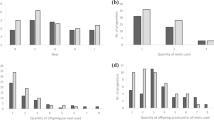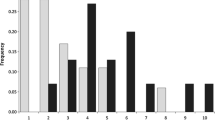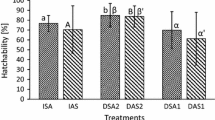Abstract
We used random amplified polymorphic DNA (RAPD) to determine paternity in two groups of brown lemurs (Eulemur fulvus mayottensis). We analyzed the results in relation to behavioral data on observed copulations, dominance relationships among adult males, and female behavior. The association between paternity determination and behavioral sampling shows that paternity determination is a crucial tool for understanding the mating strategies and reproductive success in the studied species. In brown lemurs, dominance relationships between males are correlated with reproductive success, but male social dominance could be altered by female choice as suggested by the ability of subordinate males to sire offspring in the presence of a dominant male.
Similar content being viewed by others
REFERENCES
Bardakci, F., and Skibinski, D. O. F. (1994). Application of the RAPD technique in tilapia fish: Species and subspecies identification. Heredity 73: 117-123.
Boskoff, K. J. (1978). Behavioral fluctuations in Lemur fulvus: Within and without the breeding season. In Chivers, D. J., and Herbert, J. (eds.), Recent Advances in Primatology, Vol. 1. Behaviour, Academic Press, London, pp. 503-505.
Budnitz, N., and Dainis, K. (1975). Lemur catta: Ecology and behavior. In Tattersall, I., and Sussman, R. W. (eds.), Lemur Biology, Plenum Press, New York, pp. 219-235.
Colquhoun, I. C. (1987). Dominance and “fall-fever”: The reproductive behavior of male brown lemurs (Lemur fulvus). Can. Rev. Phys. Anthropol. 6: 10-19.
Dunbar, R. I. M. (1979). Population demography, social organization and mating strategies. In Bernstein, I. S., and Smith, E. O. (eds.), Primate Ecology and Human Origins, Garland Press, New York, pp. 65-88.
Ellis, L. (1995). Dominance and reproductive success among nonhuman animals: A cross-species comparison. Ethol. Sociobiol. 16: 257-333.
Evans, C. S., and Goy, R. W. (1968). Social behavior and reproductive cycles in captive ringtailed-lemurs (Lemur catta). J. Zool. Lond. 156: 181-197.
Fondrk, M. K., Page, R. E., and Hunt, G. J. (1993). Paternity analysis of worker honeybees using Random Amplified polymorphic DNA. Naturwissenschaften 80: 226-231.
Fornasieri, I., Caubère, M., and Roeder, J. J. (1993). Social dominance and priority of access to drinking in Lemur macaco. Aggress. Behav. 19: 455-464.
Hadrys, H., Balick, M., and Schierwater, B. (1992). Applications of random amplified polymorphic DNA (RAPD) in molecular ecology. Mol. Ecol. 1: 55-63.
Hadrys, H., Schierwater, B., Dellaporta, S. L., Desalle, R., and Buss, L. W. (1993). Determination of paternity in dragonflies by random amplified polymorphic DNA fingerprinting. Mol. Ecol. 2: 79-87.
Harrington, J. E. (1975). Field observations of social behavior of Lemur fulvus fulvus. In Tattersall, I., and Sussman, R. W. (eds.), Lemur Biology, Plenum Press, New York, pp. 259-279.
Hrdy, S. B. (1980). The evolution of human sexuality: the lastest word and the last. Q. Rev. Biol. 54: 309-314.
Jolly, A. (1966). Lemur Behavior, University of Chicago Press, Chicago.
Kappeler, P. M. (1990). Female dominance in Lemur catta: More than just female feeding priority? Folia Primatol. 55: 92-95.
Koyama, N. (1988). Mating behavior of ringtailed lemurs (Lemur catta) at Berenty, Madagascar. Primates 29: 163-175.
Manson, J. H. (1995). Female mate choice in primates. Evol. Anthropol. 4: 192-195.
Morland, H. S. (1993). Reproductive activity of ruffed lemurs (Variecia variegata variegata) in a Madagascar rain forest. Am. J. Phys. Anthropol. 91: 71-82.
Neveu, H. (1997). Etude génétique comparative de groupes captifs et sauvages de 2 espèces de Lémuriens: Microcebus murinus et Eulemur macaco, Thèse de doctorat de l'Université de Paris 6, Paris.
Neveu, H., Montagnon, D., and Rumpler, Y. (1996). Paternity discrimination in four prosimian species by the random amplified polymorphic DNA method. Folia Primatol. 67: 157-162.
Pereira, M. E., and Weiss, M. L. (1991). Female mate choice, male migration, and the threat of infanticide in ringtailed lemurs. Behav. Ecol. Sociobiol. 28: 141-152.
Pereira, M. E., Kaufman, R., Kappeler, P. M., and Overdorff, D. J. (1990). Female dominance does not characterize all of the Lemuridae. Folia Primatol. 55: 96-103.
Roeder, J. J., and Fornasieri, I. (1995). Does agonistic dominance imply feeding priority in lemurs? A study in Eulemur fulvus mayottensis. Int. J. Primatol. 16: 629-642.
Sauther, M. L. (1991). Reproductive behavior of free-ranging Lemur catta at Beza Mahafaly special reserve, Madagascar. Am. J. Phys. Anthropol. 84: 463-477.
Sauther, M. L., and Sussman, R. W. (1993). A new interpretation of the social organization and mating system of the ringtailed lemur (Lemur catta). In Kappeler, P. M., and Ganzhorn, J:. U. (eds.), Lemur Social Systems and Their Ecological Basis, Plenum Press, New York, pp. 111-121.
Symons, D. (1982). Another woman that never existed. Q. Rev. Biol. 57: 297-300.
Von Segesser, F., Scheffrahn, W., and Martin, R. D. (1994). Parentage analysis within a semi-free ranging group of Barbary macaques, Macaca sylvanus. Mol. Ecol. 3: 115-120.
Welsh, J., and McClelland, M. (1990). Fingerprinting genomes using PCR with arbitrary primers. Nucleic Acids Res. 18: 7213-7218.
Williams, J. G. K., Kubelik, A. R., Kenneth, J. L., Rafalski, J. A., and Tingey, S. V. (1990). DNA polymorphisms amplified by arbitrary primers are useful as genetic markers. Nucleic Acids Res. 18: 6531-6535.
Zumpe, D., and Michael, R. P. (1986). Dominance index: A simple measure of relative dominance status in primates. Am. J. Primatol. 10: 291-300.
Author information
Authors and Affiliations
Rights and permissions
About this article
Cite this article
Gachot-Neveu, H., Petit, M. & Roeder, J.J. Paternity Determination in Two Groups of Eulemur fulvus mayottensis: Implications for Understanding Mating Strategies. International Journal of Primatology 20, 107–119 (1999). https://doi.org/10.1023/A:1020588301716
Issue Date:
DOI: https://doi.org/10.1023/A:1020588301716




